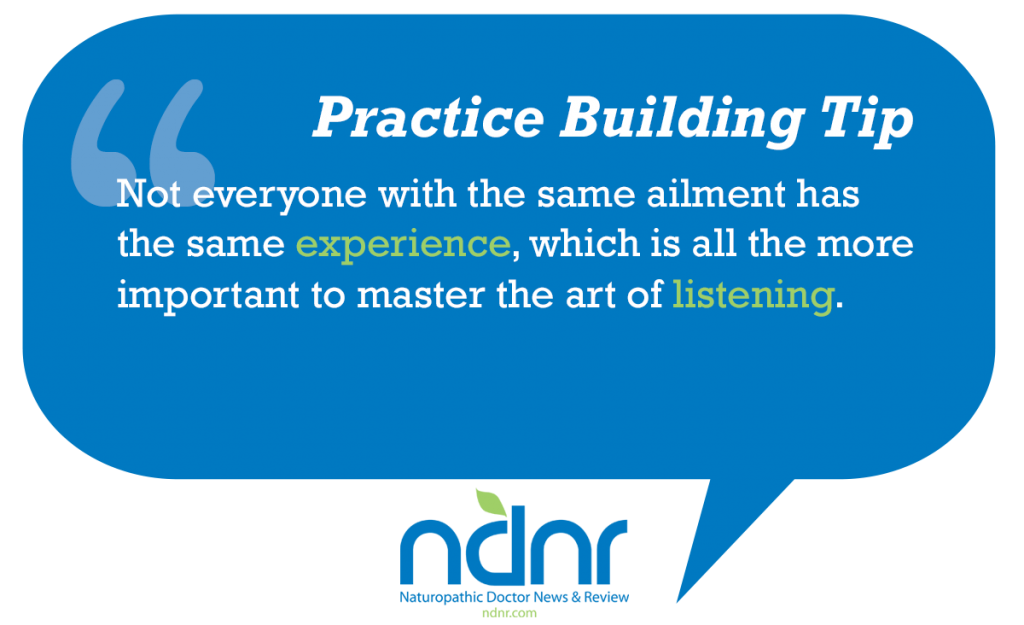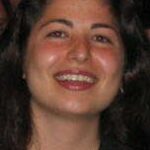Lena Kian, ND
Just listening to people generously strengthens them, because they can become more fully present. They are not trying to keep parts of themselves out of the room. They can be there in one piece. As you listen to someone, they stop fixing themselves in order to get approval, and remember who they are. Anything that has been fixed is not as strong as something that is whole. We have learned to become ashamed of our wholeness in this culture. There are parts of ourselves that we are ashamed of, that we hide, which are the very parts we may need in order to recover – either to recover from an illness or to live well with an illness.
Dean Ornish, MD1(p206)
As NDs, we excel at spending adequate time with patients. We get a thorough medical history, and guided by the rich principles of naturopathic medicine, we generate a comprehensive treatment plan. In fact, our treatment plans are so comprehensive that we may consider each patient’s level of commitment to the suggested plan so that they are not overwhelmed. The treatment plan represents actions that the patient needs to take to restore health. However, does the healing begin once the patient begins to follow the treatment plan that we recommend? In essence, healing can begin much sooner than that. Healing can begin in our offices, the instant we meet the patient, whether for the first time or upon each visit. The art of listening, having a healing presence, and creating therapeutic space in our offices is truly one of the greatest gifts we can offer our patients.
I am often perplexed by patients who thank me “just” for listening. Early in my practice, I focused more on gathering information in order to create a treatment plan. This was more the means to an end, which is why I thought I hadn’t done anything yet for the patient to be thanking me. I felt this especially during a homeopathic intake. Some patients would show me gratitude for “listening”, when to me the work had just begun: studying the case, repertorizing, and analyzing. ‘Don’t thank me until I have found the right remedy’, I thought to myself. But one clear day I heard the patient’s voice again saying “thanks for listening”, and I wondered, “Haven’t other doctors listened to them before, or at least haven’t they listened to them to the depth that we do?” After all, it has been said in homeopathy that “a case well-taken is a case half-cured”. I am also reminded of the many instances when the patient on a return visit says: “I thought about the question you asked me last time”, and then will bring about new insights, which help us get deeper to the root cause. Many times, I do not even recall the question, as they are more open-ended in nature, encouraging the patient to connect within. It does not even have to be a question. A simple statement such as “Tell me more” can help the patient initiate a deeper sense of self-awareness and reflection. This process began during the initial intake, while as doctors our focus may have been on formulating a treatment plan to instigate the healing process. I now appreciate that healing begins the instant we meet the patient. Our presence, our encounters, and the space we create in our office for the patient to express their innermost and true-selves are the source of this healing.
Presence and the Art of Listening
Presence is the necessary component for creating a therapeutic and healing environment in our office. It is about letting go of our personal and professional pasts, or thoughts of the future. It requires us to be fully alert in order to actively listen to the person seeking our care. When patients sense that they have our undivided attention, it encourages them to become present as well. Furthermore, active listening is more than a reliance on our auditory perception. We must also pay attention to the patient’s body language, their choice of words, the tone of their expressions, as well as their attitudes, beliefs, emotional state and sensations. This is especially important with patients who are fixated on their particular diagnoses. Having been ‘labeled’ with conditions such as depression, anxiety, chronic fatigue, or fibromyalgia, does not provide any space for the patients to express their unique selves. Thus, in many ways the diagnosis is a means to an end, and bypasses the art of listening. If patients are given the time and the environment to express the innermost expression of their ailments, that in and of itself can be an invaluable step towards healing. I believe that presence not only creates a therapeutic doctor-patient relationship and initiates healing in our patients, but it will also allow for the creation of a more meaningful treatment plan.
In the words of Dr. Bernie Siegel, “We must realize the pain most people suffer, and redefine our goals. What is healing? Is it a liver transplant or cure of an illness, or is it getting people to have peace of mind and live life to its fullest?”2(p23) Siegel goes further to state that, “One of the most important factors is a patient’s confidence in having the doctor’s undivided attention.”2(p45) This is essentially the art of listening, which has its roots in simply being present with the patient. Listening opens the lines of communication and makes the doctor-patient relationship more intimate. Many doctors resist such intimacy out of fear of transference. In that regard, amongst the greatest inspirational physicians, Dr. Patch Adams, says it best: “But without intimacy how can healers offset the pain and suffering they are so helpless to cure? Physicians need freedom to cry with patients, to hug them and cradle them in their arms, and to receive the same care in return. Human communication without this exchange of love is phony. It is painful to be a fake.”3(p35) Adams goes on to say, “Transference is inevitable. Every human being has some kind of impact on another. Don’t we want that in the doctor-patient relationship? Some studies have shown that the doctor’s mere presence can exert a positive impact on the patient’s health.”3(pp35-36) Being present when listening creates therapeutic space from which patients connect with their Vis. It also allows the patient to examine emotions and sensations from a different perspective that may not be so stressful or seem so threatening. Instead, there is a shift in consciousness toward homeostasis and healing.
Stress and the Mind/Body Connection
Hans Selye, the great physician and endocrinologist who recognized the role that stress has on disease, has been quoted as saying: “the great majority of physical illnesses have in part some psychosomatic origin.”2(p71) In many instances, stress is subjective and dependent upon one’s reaction to a particular environment. Not everyone with the same ailment has the same experience, which is all the more important to master the art of listening. Many stressors have their roots in suppressed emotions, mainly of helplessness, grief, anger, and failure, which may eventually be expressed in the physical body. In Anatomy of an Illness, Norman Cousins states: “Physicians must resist the idea that technology will some day abolish disease. As long as humans feel threatened and helpless, they will seek the sanctuary that illness provides.”4(p135) Furthermore, in Love and Survival, Dr. Dean Ornish states: “The real epidemic in our culture is not only physical heart disease, but also what I call emotional and spiritual heart disease— that is, the profound feelings of loneliness, isolation, alienation, and depression that are so prevalent in our culture with the breakdown of the social structures that used to provide us with a sense of connection and community. It is, to me, a root of the illness, cynicism, and violence in our society.”1(pp12-13)
The essence of stress management often goes beyond nutritional counseling and providing adaptogenic botanicals. This is not to lessen the truly healing values of such therapies, but to also connect with the patient on a deeper level. I recently had a young female patient seeking treatment for ulcerative colitis, which developed 3 years ago. She was also diagnosed with anxiety and took both antianxiety and antidepressant medications. She had chronic smoking and drinking habits, which began in her teenage years when she was raised in an impoverished environment and acted as the caregiver for her younger siblings. She described her current living environment as supportive and nourishing; however, had deep-seated fears of poverty and abandonment. Despite taking an immunosuppressive medication, she continued to have bloody diarrhea up to 12 times per day. After recommending the Elimination/Challenge diet, she reported that she had no food reactions. Yet, within one month the frequency of her stools reduced to twice daily and was formed with no blood! Puzzled, I asked her what she attributed to her health improving? She reported that it was a surprise to her that I reserved so much of the first visit to learning about her anxiety state, when she was more fixated on her colitis. This gave her a new perspective on what it means to treat the whole person. Thus, she made the connection between her state of anxiety and her digestion. The Elimination diet heightened her awareness of eating a whole foods diet, which helped her bowels significantly, and allowed her to examine her deeper emotions and unexplored fears. Working together over the next two months, the patient successfully weaned off her antianxiety and antidepressant medications, and quit smoking. She continues to improve and with each follow-up visit radiates with greater confidence and strength. I believe it is such cases that deepen my passion for naturopathic medicine. No two patients are alike, and expanding our understanding of the mind, body, and spirit rewards not only the patient, but the doctor as well.
 Lena Kian, ND is currently in practice in Northern California. She received her Doctorate of Naturopathic Medicine from Bastyr University, and her Bachelor of Science Degree in Biopsychology from the University of British Columbia. She is passionate about natural medicine and community work, and is currently on the Board of Directors at the California Naturopathic Doctors Association (CNDA). Dr. Kian believes that given the opportunity and a supportive environment, the body has an incredible ability to heal itself.
Lena Kian, ND is currently in practice in Northern California. She received her Doctorate of Naturopathic Medicine from Bastyr University, and her Bachelor of Science Degree in Biopsychology from the University of British Columbia. She is passionate about natural medicine and community work, and is currently on the Board of Directors at the California Naturopathic Doctors Association (CNDA). Dr. Kian believes that given the opportunity and a supportive environment, the body has an incredible ability to heal itself.
References
- Ornish D. Love and Survival. New York, NY: Harper Collins Publisher, Inc; 1998.
- Siegel BS. Love, Medicine & Miracles. New York, NY: Harper & Row Publishers, Inc; 1986.
- Adam P. Gesundheit. Rochester, VT: Healing Arts Press; 1993.
- Cousins N. Anatomy of Illness. New York, NY: W. W. Norton & Company, Inc; 1979.

